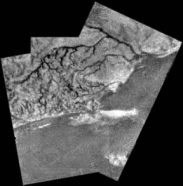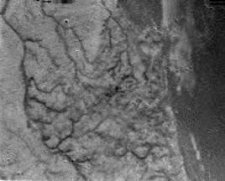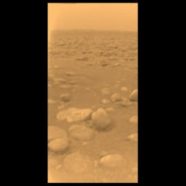Unveiling Titan
A space probe that landed on Saturn's frigid moon Titan found a landscape that looks a lot like Earth.
By Emily Sohn
There’s no place like home. Except, maybe, for Saturn’s largest moon, Titan. A recent mission to this moon has found that it looks a lot like our planet.
 |
|
This view from the Huygens space probe shows ridges and river channels on the surface of Titan.
|
| ESA/NASA/JPL/University of Arizona |
The journey began 7 years ago, when the Cassini spacecraft was launched on a mission to explore Saturn. Cassini went into orbit around the planet on July 1, 2004. Then, on Dec. 25, 2004, the European Space Agency’s Huygens probe separated from the craft and coasted toward Titan. On Jan. 14, it plunged into the moon’s atmosphere.
The probe spent 2.5 hours gliding through Titan’s atmosphere, and it sent signals from the moon’s surface to Cassini for 70 minutes before it lost radio contact with the spacecraft. Cassini, in turn, relayed the information and pictures to astronomers in Germany.
The scientists were surprised at how Earth-like Titan appeared. Huygens landed on ground that was hard on top but soft underneath, somewhat like wet sand. The researchers were able to decipher the ground’s texture by measuring the force of the probe’s impact and comparing it to the effect of forces on various types of terrain on Earth.
 |
|
One of the first Huygens images of Titan’s surface showed drainage channels leading to a shoreline.
|
| ESA/NASA/JPL/University of Arizona |
Huygens took spectacular pictures of drainage channels leading to a shoreline. Photos also showed ground fog and structures that look like sandbars.
Astronomers are especially interested in Titan’s chemistry, because the moon might provide insights into Earth’s early history. Just as Huygens landed, it measured a sharp rise in methane gas. Now, scientists suggest that the moon’s channels were carved by liquid methane and ethane, instead of by water, as they would be on Earth.
 |
|
The first color image from Titan’s surface reveals an orange sky and rocky landscape. The small “rocks” visible near the Huygens landing site are probably made of water-ice.
|
| ESA/NASA/JPL/University of Arizona |
Titan’s rocks appear to be made mainly of water-ice. Some of them look like river rocks on our planet. They were probably made round by rolling around in liquid.
Titan and Earth have something else in common, too: nonstop weather and geological activity. Huygens showed no major craters on the moon’s surface. Icy eruptions and rain probably keep the landscape rugged and constantly changing.
Another mission to Saturn’s famous moon probably won’t happen again for decades. But when spacecraft do eventually get there again, there will probably be plenty more surprises.—E. Sohn
Going Deeper:
Cowen, Ron. 2005. A world unveiled: Crème brûlée on Titan. Science News 167(Jan. 22):51. Available at http://www.sciencenews.org/articles/20050122/fob1.asp .
______. 2004. A Titan of a mission. Science News 166(Nov. 20):328-329. Available at http://www.sciencenews.org/articles/20041120/bob8.asp .
Peterson, Ivars. 2004. Mysterious Titan. Science News for Kids (Nov. 17). Available at http://www.sciencenewsforkids.org/articles/20041117/SciFiZone.asp .
Sohn, Emily. 2004. Ringing Saturn. Science News for Kids (July 28). Available at http://www.sciencenewsforkids.org/articles/20040728/Feature1.asp .
Information about the Cassini-Huygens mission to Saturn can be found at saturn.jpl.nasa.gov/home/index.cfm (NASA).
Additional information about the Huygens space probe and its findings is available at www.esa.int/SPECIALS/Cassini-Huygens/SEMHB881Y3E_0.html (European Space Agency).







